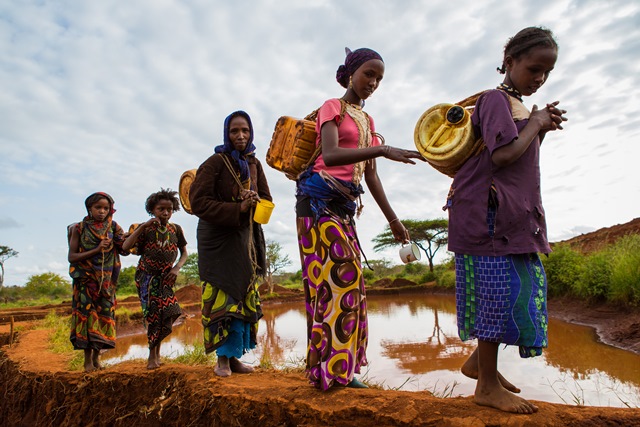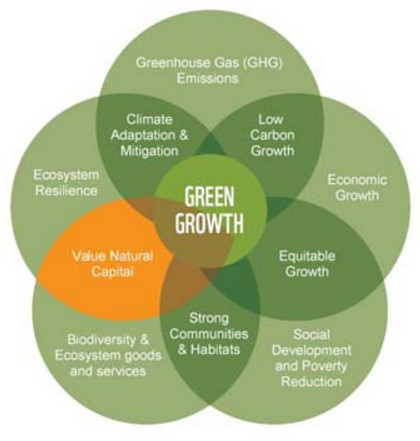1. This year’s theme for the Africa Environment Day is “Strengthening Women’s Rights over Natural Resources”. ILO was part of the COP21 debate last December in Paris. Are there any concrete signs of hope for Africa, and African women in particular?
African countries contribute only about 3.8 per cent of global greenhouse gas emissions responsible for climate change. However, Africa is the most vulnerable continent to the effects of climate change. Climate change impacts such as drought, flooding, heat stress and tropical cyclones present high risks of damage in productive sectors, business infrastructure, jobs and livelihoods. This is why African trade unions say that climate change is clearly a labour issue.
Agriculture is the most climate-sensitive sector for Africa. Over 90 percent of African agriculture relies on rainfall. There are indications that by 2020, in some countries, yields from rain-fed agriculture could be reduced by up to 50 per cent (IPCC, 2007). At warming exceeding 3°C globally, virtually all of the present maize, millet, and sorghum cropping areas across Africa could become unviable for current cultivars. Given the large number of African women and men involved in agriculture, any negative impacts on production translates into impoverishment. For example, following severe food production shocks in Malawi, Uganda, and Zambia, poverty has been estimated to have increase by up to one percent.

For fisheries in West Africa, where women are highly involved in distribution, marketing and local transformation of fish products, fish catches could decline by as much as 50 percent by the 2050s (compared to 2000 levels. This will not only impact food consumption, given that fish accounts for as much as 50 percent of the animal protein consumed, but also employment in the sector.
The tourism sector already sees the impacts of extreme summertime temperatures, loss of biodiversity and natural attractions, and damage to infrastructure as a result of extreme weather events. For example, tourism facilities of Mombasa in Kenya, located in coastal zones, which are under threat of sea-level rise. In its climate change action plan, Senegal that relies on seaside tourism for 50 percent of the sector, due to coastal erosion, 30 percent of hotels in the famous resort area of Saly have lost access to the beach, leading to business closure and layoffs.
For all these reasons, the Common African Position (CAP) on climate change negotiations, developed by the Af¬rican Group of Negotiators and endorsed by the African Ministerial Conference on the Environment, puts adaptation and access to financing as Africa’s priorities.
One can consider that African countries successfully negotiated a balanced agreement that addresses both mitigation and adaptation in equal importance, at least in its articulation and the political importance adaptation received. This is a positive step, as it means that challenges that African women will face in the wake of climate change will not be ignored. It now matters to ensure an effective action on written commitments will take place. In doing, as said in the agreement, countries must promote and consider gender equality and gender-sensitive actions.
2. Are women more likely to be strongly affected by climate change and environmental degradation in Africa?
In rural Africa, women’s dependence on natural resources for family needs in the form of water and wood gathering makes them highly vulnerable to the depletion of natural resources and climate change. The global initiative on The Economics of Ecosystems and Biodiversity (TEEB) has shown that intact ecosystems assure the survival of the poorest people, who depend for up to 80 per cent of their livelihoods on functioning ecosystems. The healthier ecosystems are, the easier life will be for a vast majority of women in Africa.
Beyond access to resources, women and children are particularly vulnerable to the phenomenon of indoor air pollution. Such pollution is caused by indoor pollutants from cooking stove fuels such as wood, coal, and cow dung predominant in rural contexts, but also urban areas of Africa.
Since men have yet to bridge their gender gap in cooking, it is mostly women and children in the kitchen of households that spend more time breathing in smoke and soot from leaky coal and wood cook stoves. The World Health Organization estimates that air pollution was linked to 4.3 million premature deaths in 2012 in households cooking over coal, wood and biomass stoves. That is more deaths than are caused by HIV/AIDS, around 1.6 million per year and malaria, around 627,000.
This is why the imperative of a transition towards clean energy is not simply about climate change and energy access. It is also, and importantly so, about women’s health. A decisive move to provide access to clean energy will offer important co-benefits in terms of creating new jobs which the International Agency for Renewable Energy (IRENA) estimated to be over 7 million jobs in 2015, in addition to reducing woman and child mortality in Africa.
The Paris agreement on climate change acknowledges the need to promote universal access to sustainable energy in developing countries, in particular in Africa, through the enhanced deployment of renewable energy. While in Paris, African countries launched the Africa Renewable Energy Initiative (AREI). This initiative aims to add an additional 10 GW and 300 GW of renewable energy capacity to the African energy sector by 2020 and 2030, respectively.
3. Smallholder farmers, many of them women, are the lifeblood of agriculture on the continent. What are the links between women entrepreneurship development, skills and green jobs for Africa?

Smallholder farmers are found to be among the least resilient to climate such impacts. The good news is that responses to climate change in agriculture can open up new opportunities for women entrepreneurship development, skills and green jobs, as new farming methods are promoted, while the demand for sustainable products such as organic foods and drinks grow.
The International Federation of Organic Agriculture Movements (IFOAM) says that in many African countries, it can observe women farmers, businesswomen, and women leaders who are promoting organic agriculture. Indeed, the market for organic products continues to be one of the fastest growing retail industries. It was estimated to be worth US$59.1 billion in 2011. This growth is fuelled by consumer demand primarily in northern markets, related to changing consumption patterns and growing consumer preference for healthier food and beverages. However, developing countries dominate production, which means business and trade opportunities which some African countries and producers are already seizing.
Biofresh Ltd in Uganda, managed by Sonia Mwadime, exports certified organic fruits and vegetables from Uganda to the EU, while applying fair trade principles. Mwadime says that her company pays premium prices to farmers 50 -100 percent higher than what they get from the local markets. According to (IFOAM), Uganda has the second largest number of organic producers – 187,893 – behind India, but significantly ahead of Mexico, Ethiopia, Tanzania and Peru.
Women are also present in new forms of sustainable intensification of African agriculture with greener approaches. Such methods of farming provide opportunities of higher skilled job, training, local multiplier benefits and extended circulation of local income in rural communities for both on- and off-farm activities. For example, the use of fodder crops cultivated primarily for animal feed, have provided opportunities for women to get involved in livestock and agro-forestry. Projects implemented in East Africa have used selected fodder shrub species as reliable sources of less expensive and easily available protein feeds for improving milk production in smallholder farms in East Africa. It is estimated that 205,000 smallholder dairy farmers (40–50 per cent being women) have planted fodder shrubs. These fodder shrubs contributed about US$3.8 million annually to farmers’ incomes across the region. These are programme that could find space in one of Africa’s regional initiatives on climate change – the Great Green Wall for the Sahara and Sahel Initiative.
With greater access to land rights and capital, women could play a far greater role in the sustainable agricultural transformation of Africa. The FAO suggests that if the gender gap in agriculture were closed, allowing women to have same access to productive resources and opportunities as men do, women could increase yields on their farms by 20-30 percent. This could raise total agricultural input in developing countries by 2.5-4 percent which could, in turn, reduce the number of hungry people in the world by 12-17 percent.
However, this potential may not be fully realize if women lack the technical skills, business development support and access to finance that anyone would need to thrive. In this context, the ILO has been promoting an approach to skills development linked to green entrepreneurship promotion. The ILO led- youth entrepreneurship facility implemented in Kenya, Tanzania and Uganda demonstrated that youth African women and men can turn their energy and ideas into business opportunities to increase their incomes and create decent work for themselves and others. Several new business, some led by young African women, have been started in waste management and recycling, value addition in agriculture (ILO, Green Jobs ).
4. What are ILO's specific policy recommendations for women to benefit from green jobs in Africa?
For ILO, gender equality has been the core value of its work since its founding in 1919. The ILO firmly considers that without consistent gender mainstreaming in all aspects of development, sustainability in a green economy is inconceivable.
The ILO Green Jobs Programme has devoted a dedicated effort to examine the gender dimensions of green job promotion. This analysis on gender equality on green job led to the realisation that an important starting point for policy advice and technical support is the understanding that there are significant gender differences in social and economic development; consumption patterns; aspirations; access and use of knowledge; approach to environmental issues; ecological footprints; use, access and control of environmental resources; and management of the environment (ILO 2015).
The emerging green sector offers an opportunity to address the many pre-existing employment challenges faced by women in the conventional labour market. Since new skills are needed in new occupations as well as changing occupations in the green economy, women can benefit from such opportunities, and enter sectors traditionally dominated by men. New entrepreneurship opportunities can also serve women, as there are no pre-existing gender biases. The examples in agriculture, energy, or waste management demonstrate that women has the potential to be pioneering entrepreneurs.
A positive factor is that the new Sustainable Development Goals have set specific goals both to “Achieve gender equality and the empowerment of women and girls” (SDG Goal 5) and many related to environmental sustainability, not least the Goal 13 on climate change.
In November 2015, the ILO Governing Body adopted the Guidelines for a just transition towards environmentally sustainable economies and societies for all. These guidelines offer countries a menu of policies that countries can draw on, including on gender mainstreaming.
5. How can we effectively promote green technology innovation and transfer in Africa?
In many sectors, innovation, the development on new skills and knowhow, are required to produce goods and services that can be competitive in a low-carbon and climate-resilient economy. There exist mechanisms under the United Nations Framework Convention on Climate Change (UNFCCC), including the Technology Mechanism which supports developing countries to develop and transfer climate technologies and accelerate sustainable development and the Climate Technology Centre and Network (CTCN) which is the operational arm of the Technology Mechanism.
But it is also important to note that across Africa, there are many institutions engaged in the promotion of innovation, development and transfer of technologies that are needed for African countries. These regional or sub-regional institutions can make a valuable contribution and should to be reinforced. For example, the ECOWAS Center for Renewable Energy and Energy Efficiency (ECREEE) established under the auspices of the Economic Community of Waste African States (ECOWAS) and located in Cape Verde works not only in the area of capacity development, training national institutions, but also promotes investment and business development.
An important role for the world of work, the ILO in particular, could be to bring support for human capital in terms of skills, entrepreneurship, employment creation, and social protection, which are indispensable in addition to technology-based and technical solutions that institutions mentioned above deliver.
This blog was originally posted on the ILO website.

